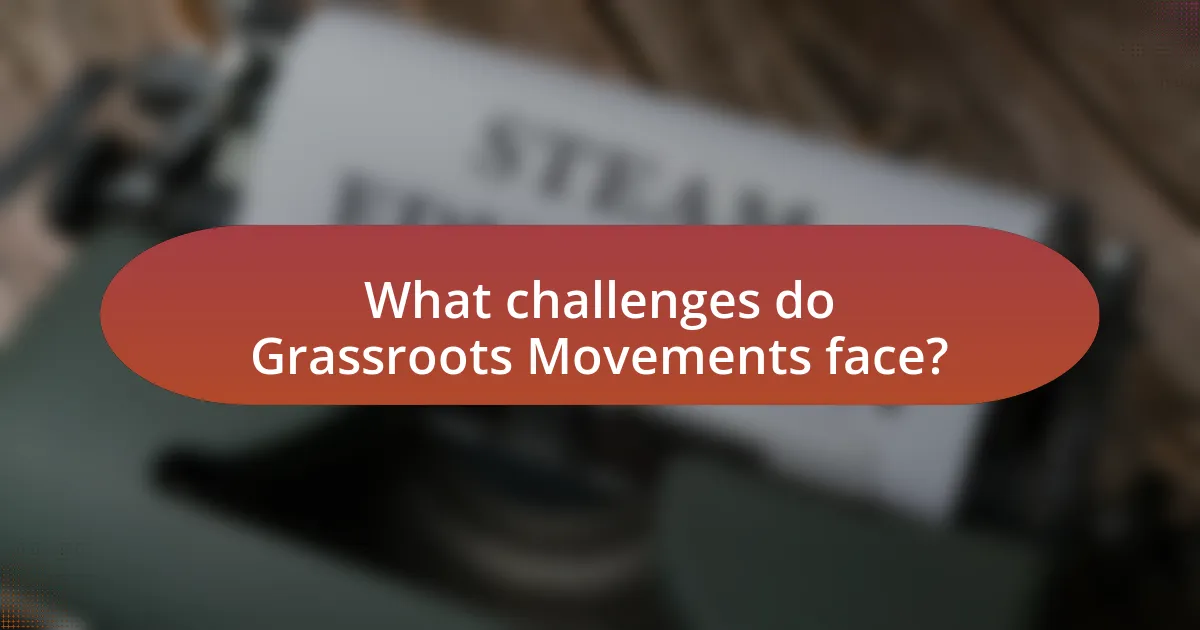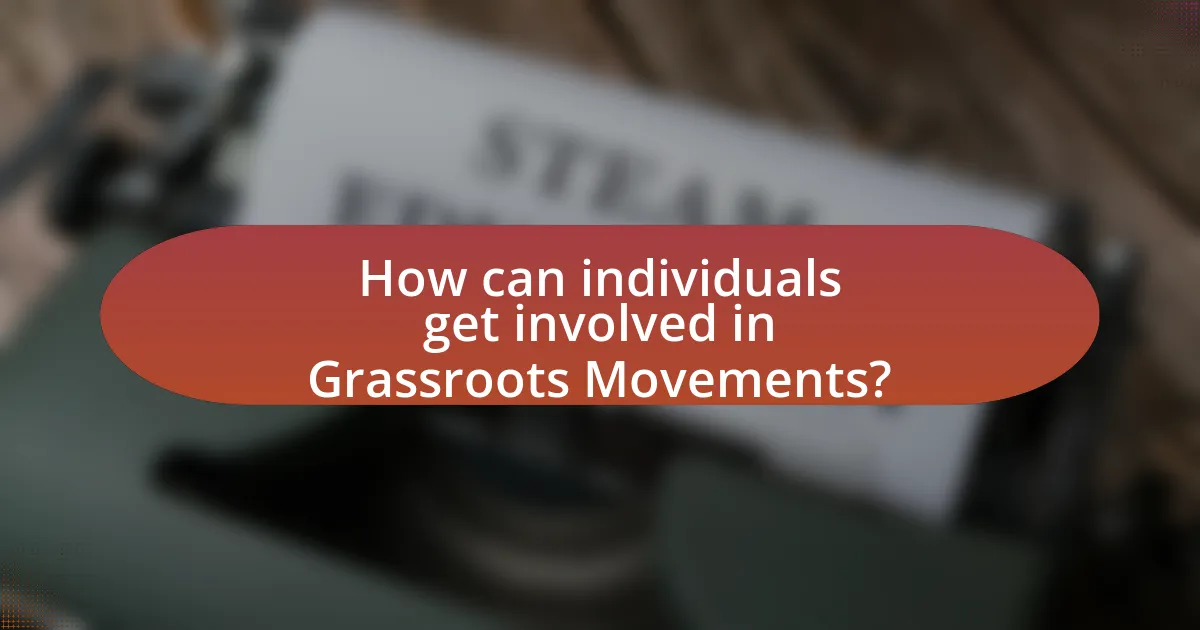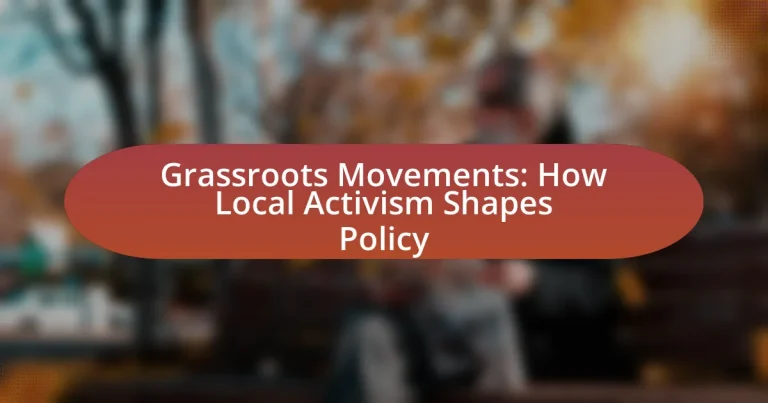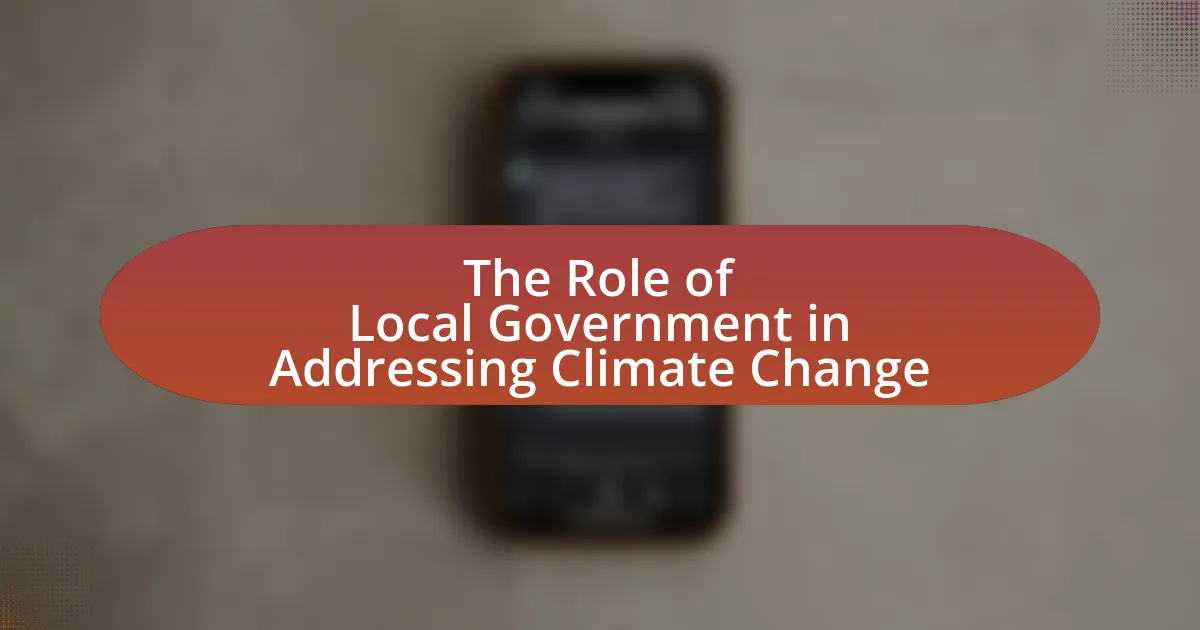Grassroots movements are collective efforts initiated by ordinary individuals at the local level to drive social or political change, often in response to specific community issues. These movements differ from traditional activism by being decentralized and community-driven, emphasizing local engagement and direct action. Key characteristics include inclusivity, collective action, and the use of strategies such as protests and social media to influence policy. Grassroots movements play a crucial role in empowering communities, addressing immediate needs, and challenging established power structures, while also facing challenges like limited funding and legal obstacles. Successful examples demonstrate their capacity to effect significant policy changes through mobilization and advocacy.

What are Grassroots Movements?
Grassroots movements are collective efforts initiated by ordinary people at the local level to effect social or political change. These movements often arise in response to specific community issues, mobilizing individuals to advocate for their rights, influence policy, or raise awareness about particular causes. Historical examples include the Civil Rights Movement in the United States, which was driven by grassroots activism to combat racial segregation and discrimination, demonstrating the power of local engagement in shaping national policy.
How do Grassroots Movements differ from traditional activism?
Grassroots movements differ from traditional activism primarily in their structure and approach, with grassroots movements being community-driven and often decentralized, while traditional activism typically involves established organizations with hierarchical structures. Grassroots movements mobilize local communities to address specific issues, relying on collective action and direct participation, as seen in movements like the Civil Rights Movement, which emphasized local leadership and community engagement. In contrast, traditional activism often utilizes formal channels, such as lobbying and institutional advocacy, which can lead to slower responses to community needs. This distinction highlights how grassroots movements can rapidly adapt to local concerns, fostering immediate change through direct action and local solidarity.
What are the key characteristics of Grassroots Movements?
Grassroots movements are characterized by their community-driven nature, local engagement, and emphasis on collective action. These movements typically emerge from the needs and concerns of ordinary people rather than established political institutions. They often prioritize inclusivity, encouraging participation from diverse community members to amplify voices that are often marginalized. Additionally, grassroots movements utilize direct action strategies, such as protests and community organizing, to effect change and influence policy decisions. Historical examples, such as the Civil Rights Movement in the United States, demonstrate how grassroots activism can lead to significant social and legislative changes, validating the effectiveness of this approach in shaping policy.
Why are Grassroots Movements important in today’s society?
Grassroots movements are important in today’s society because they empower individuals to influence political and social change at the local level. These movements mobilize communities to address issues that directly affect their lives, fostering civic engagement and participation. For instance, the Black Lives Matter movement has significantly impacted discussions on racial justice and police reform, demonstrating how grassroots activism can lead to policy changes and increased awareness of systemic issues. Additionally, studies show that grassroots efforts can effectively challenge established power structures, as seen in the success of various environmental movements that have led to local policy shifts regarding sustainability and climate action.
What role do local communities play in Grassroots Movements?
Local communities are essential in grassroots movements as they provide the foundational support, mobilization, and local knowledge necessary for effective activism. These communities often identify specific issues affecting their lives, which drives the grassroots agenda and fosters collective action. For example, the Civil Rights Movement in the United States was largely propelled by local communities organizing protests and advocating for change, demonstrating how grassroots efforts can influence national policy. Additionally, research by the Stanford Social Innovation Review highlights that grassroots movements led by local communities are more likely to achieve sustainable change because they are rooted in the specific needs and contexts of those communities.
How do community needs shape the objectives of Grassroots Movements?
Community needs directly shape the objectives of grassroots movements by prioritizing local issues that resonate with residents. Grassroots movements emerge from the collective concerns of community members, such as social justice, environmental protection, or economic inequality, which drive their goals and strategies. For instance, the Civil Rights Movement in the United States was fundamentally shaped by the community’s demand for racial equality and justice, leading to specific objectives like desegregation and voting rights. This alignment ensures that grassroots movements remain relevant and effective, as they address the immediate and pressing needs of the community, fostering greater participation and support.
What are examples of successful local activism initiatives?
Successful local activism initiatives include the “Living Wage Campaign” in various U.S. cities, which successfully advocated for higher minimum wages, resulting in policy changes in cities like Seattle and San Francisco. Another example is the “Stop the Frack Attack” movement, which mobilized communities across the United States to ban hydraulic fracturing, leading to local bans in places like New York State. Additionally, the “No More Deaths” initiative in Arizona has focused on humanitarian aid for migrants, influencing local policies on immigration and border enforcement. These initiatives demonstrate the power of grassroots movements in shaping local policy through community engagement and advocacy.
How do Grassroots Movements influence policy change?
Grassroots movements influence policy change by mobilizing community members to advocate for specific issues, thereby creating pressure on policymakers. These movements often utilize strategies such as organizing protests, engaging in lobbying efforts, and leveraging social media to raise awareness and build public support. For example, the Civil Rights Movement in the United States effectively changed legislation, such as the Civil Rights Act of 1964, through sustained grassroots activism that highlighted systemic injustices. Additionally, research indicates that grassroots campaigns can lead to significant shifts in public opinion, which in turn can compel legislators to respond to constituents’ demands, as seen in the environmental movement’s impact on climate policy.
What strategies do Grassroots Movements use to advocate for policy changes?
Grassroots movements utilize various strategies to advocate for policy changes, including community organizing, coalition building, direct action, and leveraging social media. Community organizing involves mobilizing local residents to identify issues and collectively push for change, as seen in movements like the Civil Rights Movement, where grassroots efforts led to significant legislative reforms. Coalition building allows grassroots movements to unite with other organizations, amplifying their voices and resources, exemplified by the Women’s March, which brought together diverse groups to advocate for women’s rights. Direct action, such as protests and sit-ins, serves to draw public attention and pressure policymakers, as demonstrated by the environmental protests against fossil fuel projects. Additionally, social media platforms enable grassroots movements to disseminate information rapidly, engage supporters, and organize events, significantly enhancing their outreach and impact, as evidenced by the #BlackLivesMatter movement’s ability to mobilize global support for racial justice.
How do Grassroots Movements mobilize public support for their causes?
Grassroots movements mobilize public support for their causes by leveraging community engagement, social media, and local events to raise awareness and foster collective action. These movements often begin with a small group of individuals who share a common concern, which they articulate through campaigns that resonate with the broader community. For instance, the Black Lives Matter movement effectively utilized social media platforms to amplify its message, resulting in widespread protests and increased public discourse around racial justice. Research indicates that grassroots campaigns that engage local populations through direct outreach and storytelling can significantly enhance public support, as seen in the successful mobilization efforts during the Fight for $15 campaign, which advocated for a higher minimum wage.

What challenges do Grassroots Movements face?
Grassroots movements face significant challenges, including limited funding, lack of media attention, and internal conflicts. Limited funding restricts their ability to mobilize resources effectively, as many rely on small donations or volunteer efforts. Lack of media attention hampers their visibility and outreach, making it difficult to gain public support and influence policy. Internal conflicts can arise from differing priorities or strategies among members, which can weaken their overall effectiveness. These challenges are documented in studies such as “The Role of Grassroots Movements in Policy Change” by the Institute for Policy Studies, highlighting the systemic barriers that often impede their progress.
How do funding and resources impact Grassroots Movements?
Funding and resources significantly impact grassroots movements by determining their operational capacity and outreach effectiveness. Adequate funding allows grassroots organizations to mobilize volunteers, conduct outreach campaigns, and sustain long-term initiatives, which are essential for influencing policy change. For instance, the 2014 Black Lives Matter movement gained momentum partly due to financial support from various donors, enabling it to organize protests and raise awareness on systemic racism. Conversely, limited resources can hinder a movement’s ability to communicate its message, engage with the community, and sustain momentum, ultimately affecting its success in achieving policy objectives.
What are common funding sources for Grassroots Movements?
Common funding sources for grassroots movements include individual donations, crowdfunding platforms, grants from nonprofit organizations, and support from local businesses. Individual donations often come from community members who believe in the cause, while crowdfunding platforms like GoFundMe allow movements to reach a wider audience for financial support. Grants from nonprofit organizations provide essential funding for specific projects or initiatives, and local businesses may contribute through sponsorships or partnerships, recognizing the mutual benefits of supporting community-driven efforts. These funding sources are crucial for sustaining grassroots movements and enabling them to effectively advocate for policy changes.
How can Grassroots Movements overcome resource limitations?
Grassroots movements can overcome resource limitations by leveraging community engagement and building strategic partnerships. By mobilizing local volunteers and fostering a sense of ownership among community members, these movements can maximize their human resources. For instance, the Black Lives Matter movement effectively utilized social media to organize protests and raise funds, demonstrating how digital platforms can amplify voices and attract financial support without significant upfront costs. Additionally, forming alliances with established organizations can provide access to funding, expertise, and networks that grassroots movements may lack independently. This collaborative approach not only enhances resource availability but also strengthens the overall impact of the movement.
What legal and political obstacles do Grassroots Movements encounter?
Grassroots movements encounter significant legal and political obstacles, including restrictive laws, lack of access to political processes, and opposition from established power structures. These movements often face legal challenges such as stringent regulations on protests and demonstrations, which can limit their ability to mobilize supporters and express dissent. For instance, laws that require permits for public gatherings can be used to suppress grassroots activism by imposing bureaucratic hurdles. Additionally, grassroots movements frequently struggle with political barriers, such as being marginalized in decision-making processes, which can hinder their influence on policy. Research indicates that established political entities may actively work to undermine grassroots efforts through lobbying or disinformation campaigns, further complicating their objectives.
How do laws and regulations affect the operations of Grassroots Movements?
Laws and regulations significantly influence the operations of grassroots movements by either facilitating or constraining their activities. For instance, legal frameworks that protect the right to assemble and express dissent enable grassroots organizations to mobilize effectively, as seen in the Civil Rights Movement in the United States, where legal protections allowed activists to organize protests and advocate for policy changes. Conversely, restrictive laws, such as those imposing heavy penalties for protests or limiting funding sources, can hinder grassroots efforts, as evidenced by recent legislation in various countries that targets non-governmental organizations and limits their operational capabilities. Thus, the legal environment directly shapes the strategies and effectiveness of grassroots movements in advocating for social change.
What strategies can Grassroots Movements employ to navigate political challenges?
Grassroots movements can employ strategies such as coalition-building, effective communication, and leveraging social media to navigate political challenges. Coalition-building allows these movements to unite diverse groups, increasing their influence and resources, as seen in the Women’s March, which brought together various organizations to advocate for women’s rights. Effective communication helps articulate their goals and mobilize supporters, exemplified by the Black Lives Matter movement’s use of clear messaging to raise awareness about racial injustice. Leveraging social media enables grassroots movements to reach a wider audience quickly, as demonstrated by the viral spread of the #MeToo movement, which highlighted sexual harassment and assault. These strategies collectively enhance the ability of grassroots movements to confront and overcome political obstacles.

How can individuals get involved in Grassroots Movements?
Individuals can get involved in grassroots movements by participating in local organizations, attending community meetings, and volunteering for campaigns that align with their values. Engaging with these groups allows individuals to contribute to collective efforts aimed at influencing policy and social change. For example, according to a report by the National Civic League, grassroots activism has been shown to effectively mobilize communities and drive legislative changes, demonstrating the impact of local involvement on broader policy outcomes.
What are effective ways for individuals to support local activism?
Individuals can effectively support local activism by participating in community events, volunteering time and skills, and donating to local organizations. Engaging in community events, such as rallies or town hall meetings, fosters awareness and solidarity among activists and the community. Volunteering provides essential support to local groups, enhancing their capacity to advocate for change. Additionally, financial contributions to local organizations enable them to sustain their efforts and expand their outreach. Research indicates that grassroots movements significantly influence policy changes, as seen in the success of local environmental initiatives that gained traction through community involvement and support.
How can volunteering enhance the impact of Grassroots Movements?
Volunteering enhances the impact of grassroots movements by increasing community engagement and mobilizing resources effectively. When individuals volunteer, they contribute time, skills, and energy, which strengthens the movement’s capacity to advocate for change. For instance, a study by the National Conference on Citizenship found that communities with higher volunteer rates experience greater civic engagement and improved social cohesion, which are critical for grassroots initiatives. This collective effort not only amplifies the movement’s voice but also fosters a sense of ownership among community members, leading to more sustainable and impactful outcomes.
What role does social media play in promoting Grassroots Movements?
Social media plays a crucial role in promoting grassroots movements by facilitating rapid communication, mobilization, and awareness. It allows activists to share information, organize events, and rally support on a large scale, often transcending geographical barriers. For instance, the Arab Spring demonstrated how platforms like Twitter and Facebook enabled citizens to coordinate protests and disseminate information quickly, leading to significant political changes in several countries. Additionally, studies show that social media campaigns can increase public engagement and participation, as seen in movements like Black Lives Matter, which utilized hashtags to amplify their message and reach a wider audience.
What best practices should individuals follow when engaging with Grassroots Movements?
Individuals engaging with grassroots movements should prioritize active listening, community involvement, and collaboration. Active listening ensures that individuals understand the needs and perspectives of the community, fostering trust and inclusivity. Community involvement, such as attending meetings and participating in local events, strengthens connections and demonstrates commitment. Collaboration with other activists and organizations enhances resource sharing and amplifies voices, leading to more effective advocacy. Research indicates that grassroots movements that emphasize these practices are more successful in influencing policy changes, as seen in the success of movements like the Civil Rights Movement, which relied heavily on community engagement and collaboration to achieve legislative reforms.
How can individuals ensure their involvement is meaningful and impactful?
Individuals can ensure their involvement is meaningful and impactful by actively engaging in grassroots movements that align with their values and goals. This engagement includes participating in local initiatives, attending community meetings, and collaborating with established organizations to amplify their efforts. Research indicates that grassroots activism can significantly influence policy changes; for instance, a study by the Stanford Social Innovation Review found that community-led campaigns often lead to more responsive governance and policy reforms. By focusing on specific issues, building coalitions, and utilizing effective communication strategies, individuals can enhance the effectiveness of their activism and contribute to lasting change.
What are common pitfalls to avoid when participating in Grassroots Movements?
Common pitfalls to avoid when participating in grassroots movements include lack of clear goals, insufficient community engagement, and failure to build coalitions. Grassroots movements often struggle when participants do not establish specific, measurable objectives, which can lead to confusion and diluted efforts. Additionally, neglecting to involve the community can result in a disconnect between the movement and the very people it aims to serve, undermining its effectiveness. Lastly, failing to collaborate with other organizations can limit resources and support, as successful movements often rely on a network of allies to amplify their message and impact.




